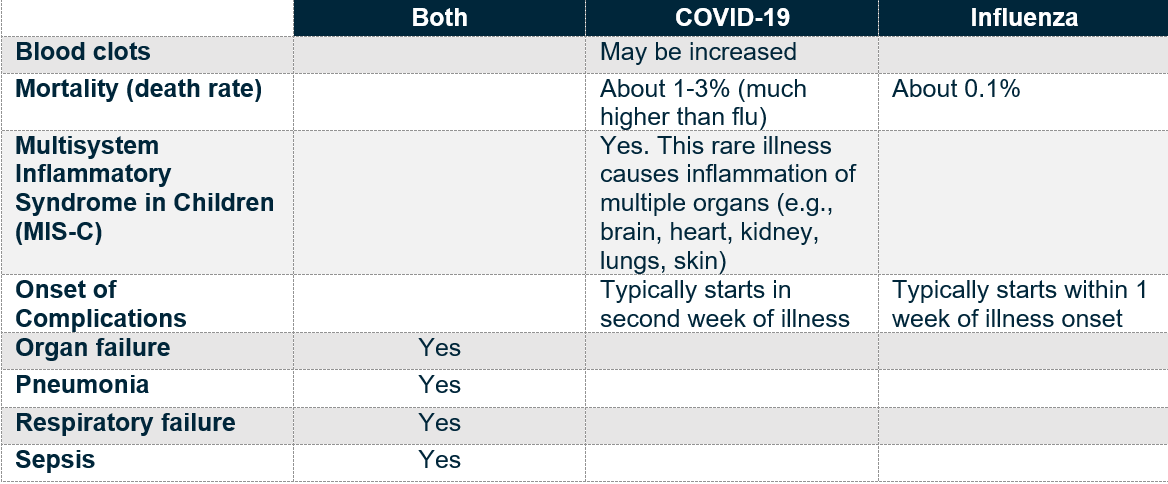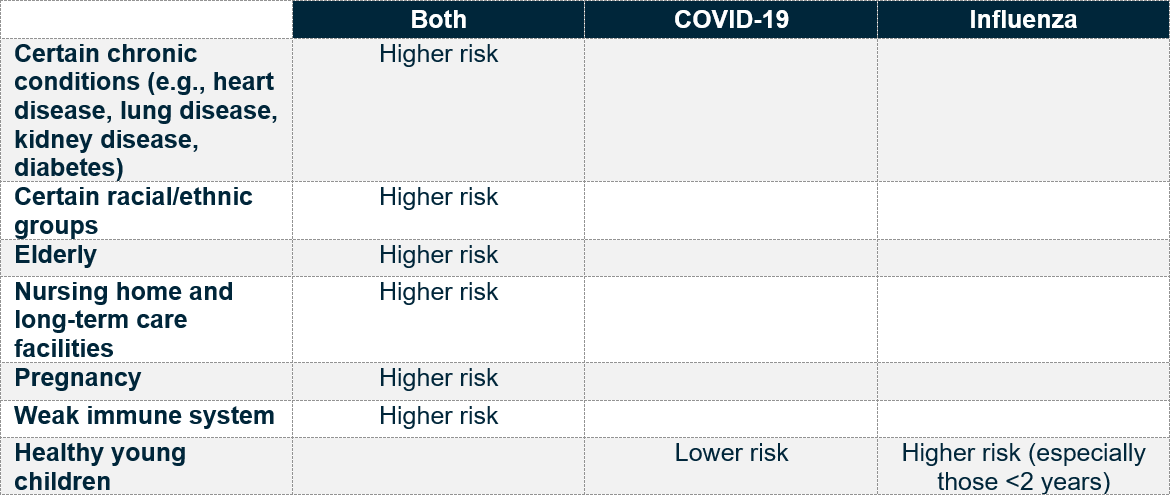COVID-19 and Influenza: What’s Different and What’s the Same
COVID-19 and flu (influenza) are both viral respiratory infections that can have similar symptoms. When both flu and COVID-19 are widespread in the community, testing will often be needed to tell them apart. However, COVID-19 and flu do have some important differences.
Below we review what’s the same and what’s different when it comes to COVID-19 and the flu. Each section will include key questions that are answered by a comparison graph.
Symptoms
Are there any symptoms that are more common with COVID-19?
How long after exposure do symptoms start with COVID-19 as compared to the flu?
Key Points
COVID-19 is suggested by a longer time from exposure to symptom onset and by loss of taste and smell.
Although less common, loss of taste and smell can happen with the flu.
How it Is Spread
Can people spread both COVID-19 and the flu (contagious) before they have any symptoms?
Key Points
A person with COVID-19 can spread the illness for a longer period of time than the flu.
Both COVID-19 and flu can be spread by people that do not have any symptoms (i.e., asymptomatic).
Complications
Are there differences in the complications of COVID-19 versus the flu?
Key Points
Death rate is higher in COVID-19 than seasonal flu (at least 10 times higher). COVID-19 is associated with MIS-C and may increase blood clots.
Severe complications often start later in COVID-19 compared to the flu.
High Risk Groups
Are young healthy children at higher or lower risk of complications from the flu compared to COVID-19?
What other groups are at higher risk?
Key Points
The elderly and those with chronic health conditions are at high risk for complications from both illnesses.
Healthy young children have a lower risk of complications from COVID-19 compared to the flu. However, children with chronic health conditions are at high risk for COVID-19 complications.
Treatment and Prevention
Does physical distancing work for both flu and COVID-19?
Key Points
Get the flu vaccine!
Get the COVID-19 vaccine when it becomes available!
Physical distancing, hand hygiene and using masks can help prevent both illnesses.
Some Final Thoughts
Remember that people can become ill with BOTH COVID-19 and other respiratory infections at the same time, including flu (i.e., coinfection).
Triagers should use their clinical judgment, but generally will want to use the COVID-19 Diagnosed or Suspected guideline when a patient calls with typical COVID-19 symptoms and there is community spread.
During the 2020-2021 influenza season, triagers can use the COVID-19 Diagnosed or Suspected guideline. We have included triage questions related to influenza as part of this updated COVID-19 guideline.
An exception would be the patient who has flu-like symptoms and has had a definite close exposure to someone with influenza (flu test positive). In this case use the Influenza guideline.
COVID-19 is still a new illness. Our understanding of symptoms, complications and treatment are changing rapidly. Good sources of up-to-date information includes the Centers for Disease Control and Prevention (https://www.cdc.gov) and the World Health Organization (https://www.who.int/).
Author
Gary Marks, DO
Medical Editor, Clinical Informaticist, Adult Clinical Content
Schmitt-Thompson Clinical Content, LLC
Co-Authors
Cheryl Patterson, RNC-TNP, BSN
Nurse Editor, Adult Clinical Content
Schmitt-Thompson Clinical Content, LLC
David Thompson, MD
Senior Medical Editor
Schmitt-Thompson Clinical Content, LLC
References
Butowt R, von Bartheld CS. Anosmia in COVID-19: Underlying Mechanisms and Assessment of an Olfactory Route to Brain Infection. Neuroscientist. 2020 Sep.
Centers for Disease Control and Prevention. Similarities and Differences between Flu and COVID-19. Available at: https://www.cdc.gov/flu/symptoms/flu-vs-covid19.htm#:~:text=Because%20some%20of%20the%20symptoms,differences%20between%20the%20two. Last accessed 11/17/2020
Centers for Disease Control and Prevention. People at High Risk For Flu Complications. Available at: https://www.cdc.gov/flu/highrisk/index.htm. Last accessed 11/17/2020
Centers for Disease Control and Prevention. Coronavirus Disease 2019 (COVID-19): People with Certain Medical Conditions. Available at: https://www.cdc.gov/coronavirus/2019-ncov/need-extra-precautions/people-with-medical-conditions.html?CDC_AA_refVal=https%3A%2F%2Fwww.cdc.gov%2Fcoronavirus%2F2019-ncov%2Fneed-extra-precautions%2Fgroups-at-higher-risk.html. Last accessed 11/17/2020
Ding Q, Lu P, Fan Y, Xia Y, Liu M. The clinical characteristics of pneumonia patients coinfected with 2019 novel coronavirus and influenza virus in Wuhan, China. J Med Virol. 2020 Mar 20:10.
Ives-Tallman C, Guest B. Novel Coronavirus 2019 (COVID-19). EmRAP CorPendium. Updated: October 27, 2020.
National Institute of Health. Influenza and COVID-19. Available at: https://www.covid19treatmentguidelines.nih.gov/special-populations/influenza/. Last accessed 11/17/2020
Tenforde MW, Kim SS, Lindsell CJ, et al. Symptom Duration and Risk Factors for Delayed Return to Usual Health Among Outpatients with COVID-19 in a Multistate Health Care Systems Network — United States, March–June 2020. MMWR Morb Mortal Wkly Rep 2020;69:993-998.
World Health Organization. Coronavirus disease (COVID-19): Similarities and differences with influenza. Available at: https://www.who.int/news-room/q-a-detail/coronavirus-disease-covid-19-similarities-and-differences-with-influenza. Last accessed 11/17/2020





